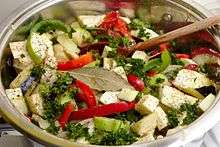Ratatouille
 | |
| Alternative names | Ratatouille niçoise |
|---|---|
| Type | Stew |
| Place of origin | France |
| Region or state | Provence |
| Main ingredients | Vegetables, (tomatoes, onions, zucchini, eggplant, bell peppers), garlic, marjoram, basil |
| Variations | Confit byaldi |
|
| |



Ratatouille (/ˌrætəˈtuːi/ RAT-ə-TOO-ee; French: [ʁatatuj]) is a French Provençal stewed vegetable dish, originating in Nice, and sometimes referred to as ratatouille niçoise.[1]
Origins
The word ratatouille derives from the Occitan ratatolha[2] and is related to the French ratouiller and tatouiller, expressive forms of the verb touiller, meaning "to stir up".[3][4] From the late 18th century, in French, it merely indicated a coarse stew. The modern ratatouille - tomatoes as a foundation for sautéed garlic, onions, zucchini, eggplant, bell peppers, marjoram, fennel and basil, or bay leaf and thyme, or a mix of green herbs like herbes de Provence - does not appear in print until c. 1930.[5]
Preparation
Felicity Cloake notes that, considering ratatouille's recent pedigree, there exists a great variety of methods of preparation for the dish.[6] The Larousse Gastronomique claims "according to the purists, the different vegetables should be cooked separately, then combined and cooked slowly together until they attain a smooth, creamy consistency", so that (according to the chair of the Larousse's committee Joël Robuchon) "each [vegetable] will taste truly of itself." [7]
In popular culture
In Pixar's 2007 animated film Ratatouille, Remy, Linguini, and Colette cook a variation of ratatouille (actually Michel Guérard's confit byaldi) to impress a restaurant critic.
Related dishes
As well as confit byaldi, related dishes exist in many Mediterranean cuisines: pisto (Castilian-Manchego, Spain), samfaina (Catalan), tombet (Majorcan), caponata and ciambotta (Sicily, Italy), briám and tourloú (Greek), şakşuka and türlü (Turkish), lecsó (Hungarian).
See also
References
- ↑ Ratatouille. Oxford English Dictionary, 2nd edition (1989)
- ↑ « ratatouio », Lou tresor dou Felibrige, Frédéric Mistral
- ↑ Alan Davidson (2014). The Oxford Companion to Food. Oxford University Press. p. 655. ISBN 978-0-19-967733-7.
- ↑ "Chef Brian Discusses The Origin of Ratatouille Nicoise". LADC. Archived from the original on 2015-10-09.
- ↑ Scotto, E., and Marianne Comolli. "Vegetables: A Garden of Eden." France, the Beautiful Cookbook: Authentic Recipes from the Regions of France. San Francisco: Collins, 1989. 195. Print."
- ↑ Cloake, Felicity (15 July 2010). "How to make perfect ratatouille". The Guardian. Retrieved 9 September 2016.
- ↑ Robuchon, Joël (2008). The Complete Robuchon. New York: Alfred A. Knopf. p. 597. ISBN 978-0-307-26719-1.
Further reading
- "How to make perfect ratatouille". The Guardian. Retrieved 9 September 2016. (Extensive discussion of variations in the preparation of ratatouille)
External links
| Look up ratatouille in Wiktionary, the free dictionary. |
| Wikibooks Cookbook has a recipe/module on |
